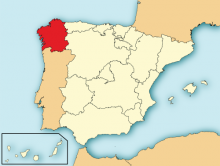You are here
Information by Autonomous Community
Galicia
Located on middle latitudes, Galicia is in a circulation area dominated by winds from the West and it is the first point of arrival of inclement weather from the Atlantic in Spain. The autonomous community of Galicia is also influenced by masses of air with very different thermodynamic characteristics. As a result, Galicia receives masses of hot, humid air (maritime tropical weather) and masses of air which originate in higher latitudes and are generally cold, albeit with different levels of humidity. Consequently, the conclusions drawn from studies on climatic variations for northern Europe or the Mediterranean do not apply directly to this community and specific studies have to be carried out for the region.
As a result, Xunta de Galicia coordinated a research project titled Analysis of Evidence and Impacts of Climate change in Galicia (Spanish acronym: CLIGAL) and the conclusions were published in the book titled Evidence and Impacts of Climate change in Galicia.
The main evidence left behind by this phenomenon in Galicia refers to increases in temperature of 0.18°C per decade (period 1961-2006), changes to the annual precipitation spread, variations to bird migration habits, phenologic changes to plant life, increases in sea surface temperatures of 0.2°C per decade, variations to outcrops with effects on estuary renewal times, which double, changes in phytoplankton and an increase in warm water species, together with rising sea levels of between 2.0 and 2.5 cm per decade.
Xunta de Galicia has also developed actions to observe and investigate the climate (for which it maintains various observation networks that focus on Galician ecosystems) and takes part in European projects designed to identify vulnerabilities and adapt to the anticipated effect of climate change. It draws up reports to help with decision-taking processes in the area of adaptation in Galicia.
Its commitment is strengthened by the Galician Climate Change and Energy Strategy 2050, which is the planning instrument in the fight against climate change and energy transition for the 2050 time horizon.
The Strategy, which is eminently participative, has counted on the active collaboration of all key agents, addressing the problem of climate change by sector of activity.
Within the field of adaptation, the Strategy has three major objectives comprising a total of 13 lines of action, determined after having carried out a sectoral diagnosis. These are:
- Objective 3: Develop and maintain observation networks and climate models adapted to Galicia. Focused on providing Xunta with the necessary tools to address the challenge of adaptation. To this end, on the one hand, the networks for monitoring the effects of climate change will be strengthened and, on the other, models will be developed to better anticipate the impacts of climate change on the territory of Galicia.
- Objective 4: Increase resilience to climate change. It consists of increasing the resilience to climate change of cross-cutting sectors and activities. It includes lines aimed at promoting a more resilient and adaptive territorial structure, as well as specific lines oriented towards natural resources, population and water.
- Objective 5: Increase resilience to climate change. involves the implementation of adaptive management in relevant sectors. This includes lines specifically oriented to the fishing, agriculture, livestock, tourism, transportation, energy and forestry sectors.




